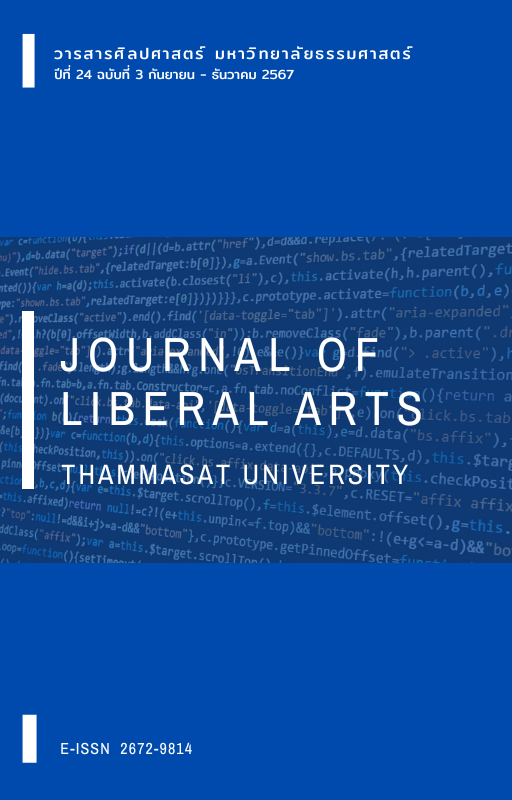การศึกษากลวิธีการแปลคำเสียดสีในวรรณกรรมเรื่อง อิท สำนวนแปลของโสภณา เชาว์วิวัฒน์กุล
Main Article Content
บทคัดย่อ
งานวิจัยนี้จัดทำขึ้นเพื่อศึกษากลวิธีการแปลคำเสียดสีและปัจจัยที่ส่งผลต่อการแปลคำเสียดสีในวรรณกรรมแปลเรื่อง “อิท” ของโสภณา เชาว์วิวัฒน์กุล โดยใช้ทฤษฏีเกี่ยวกับคำเสียดสีของ Hom and May (2013) Croom (2013) Fasoli et al. (2015) Cousens (2020) และ Anderson and Lepore (2013) กลวิธีการแปลคำเสียดสีของ Davoodi (2009) Lovihandrie et al. (2018) และโชติกา เศรษฐธัญการ (2564) กลวิธีการแปลคำในวัฒนธรรมของสุพรรณี ปิ่นมณี (2562) และกลวิธีการแปลคำทั่วไปของ Newmark (1988) ผลการวิจัยพบคำเสียดสี 5 หมวดหมู่โดยมีคำเสียดสีเกี่ยวกับเชื้อชาติ หมวดหมู่คำเสียดสีเกี่ยวกับเพศหญิง หมวดหมู่คำเสียดสีเกี่ยวกับผู้มีความหลากหลายทางเพศ หมวดหมู่คำเสียดสีเกี่ยวกับผู้มีความบกพร่องทางร่างกาย และคำเสียดสีในหมวดหมู่อื่น มีการใช้กลวิธีการแปลคำเสียดสีทั้งหมด 13 กลวิธีด้วยกันคือ กลวิธีการลบทิ้ง กลวิธีการใช้คำแทนที่ กลวิธีการเทียบเคียงคำต้องห้าม กลวิธีการแปลงเป็นคำรื่นหู กลวิธีการใช้คำยืม กลวิธีการใช้คำทั่วไป กลวิธีการใช้คำต้องห้ามแบบลดความรุนแรง กลวิธีการทับศัพท์ กลวิธีการแปลตามตัวอักษร กลวิธีการเพิ่มคำอธิบาย กลวิธีการใช้เชิงอรรถ กลวิธีการแปลแบบอิสระ และกลวิธีการแปลแบบสำนวน ผลการศึกษาพบว่าความแตกต่างและคล้ายคลึงทางด้านมุมมองของสังคมระหว่างสหรัฐอเมริกาและไทย รวมถึงการเปลี่ยนแปลงมุมมองเกี่ยวกับคำเสียดสีในวัฒนธรรมต้นทาง พร้อมทั้งปัจจัยทางด้านเจตนาในการใช้คำเสียดสีและลักษณะของตัวละครผู้ใช้คำเสียดสีล้วนส่งผลต่อการแปลคำเสียดสี
Downloads
Article Details

อนุญาตภายใต้เงื่อนไข Creative Commons Attribution-NonCommercial-NoDerivatives 4.0 International License.
เอกสารอ้างอิง
โชติกา เศรษฐธัญการ. (2564). กลวิธีการแปลคำต้องห้ามจากภาษาอังกฤษ เป็นภาษาไทยเพื่อผลิตบทบรรยายภาพยนตร์. วารสารศิลปศาสตร์มหาวิทยาลัยมหิดล, 4(2), 302-357.
ราชบัณฑิตยสถาน. (2554). เหยียด. https://dictionary.orst.go.th/
ราชบัณฑิตยสถาน. (2554). นิกรอยด์. https://dictionary.orst.go.th/
สตีเฟน คิง. (2560). It [อิท เล่มหนึ่งและเล่มสอง] (โสภณา เชาว์วิวัฒน์กุล, ผู้แปล, พิมพ์ครั้งแรก). แพรวสำนักพิมพ์ อัมรินทร์พริ้นติ้งแอนด์พับลิชชิ่ง.
สัญฉวี สายบัว. (2550). หลักการแปล. มหาวิทยาลัยธรรมศาสตร์.
สุพรรณี ปิ่นมณี. (2562). ภาษา วัฒนธรรม กับการแปล: ไทย-อังกฤษ. สำนักพิมพ์จุฬาลงกรณ์มหาวิทยาลัย.
Allan, K. (2019). Taboo words and language: An overview. In K. Allan (Ed.), The Oxford handbook of taboo words and language (1st ed., pp. 1-27). Oxford University Press.
Anderson, L., & Lepore, E. (2013). Slurring words. Nous, 47(1), 25-48.
Cousens, C. (2020). Are ableist insults secretly slurs? Language Sciences, 77, Article 101252. https://doi.org/10.1016/j.langsci.2019.101252
Croom, A. M. (2013). How to do things with slurs: Studies in the way of derogatory words. Language and Communication, 33, 177-204.
Davoodi, Z. (2009, September). Re: On the translation of the taboos [Web blog]. Translation Directory. https://www.translationdirectory.com/articles/article2052.php
Diaz-Legaspe, J. (2020). What is a slur? Philosophical Studies, 177(5), 1399-1422.
Fasoli, F., Carnaghi, A., & Paladino, M. P. (2015). Social acceptability of sexist derogatory and sexist objectifying slurs across contexts. Language Sciences, 52, 98-107. https://doi.org/10.1016/j.langsci.2015.03.003
Hom, C., & May, R. (2013). Moral and semantic innocence. Analytic Philosophy, 54(3), 293-313.
Jay, T. (1992). Cursing in America: A psychological study of dirty language in the courts, in the schoolyards and on the street. John Benjamins.
King, S. (1986). It: A novel. Scribner.
Lovihandrie, H., Mujiyanto, J., & Sutopo, D. (2018). Translation strategies used by Lingliana in translating taboo words in Sylvia Day’s Bared to You. English Education Journal, 8(2), 208-220.
Merriam-Webster. (n.d.). Slur. In Merriam-Webster.com dictionary. Retrieved October 21, 2023, from https://www.merriam-webster.com/dictionary/slur
Newmark, P. (1988). A textbook of translation. Prentice Hall.
van Boxtel, Y. (2021). Howard’s fear – Reanimated lovecraftian racism: Black representation in American horror literature. Radboud University.


